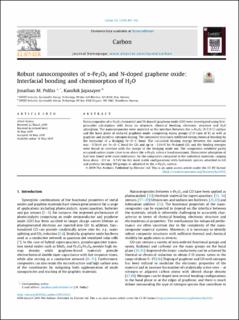Robust nanocomposites of a-Fe2O3 and N-doped graphene oxide: Interfacial bonding and chemisorption of H2O
Peer reviewed, Journal article
Published version
Permanent lenke
https://hdl.handle.net/11250/2720942Utgivelsesdato
2019Metadata
Vis full innførselSamlinger
- Publikasjoner fra CRIStin - SINTEF AS [5801]
- SINTEF Industri [1565]
Sammendrag
Nanocomposites of α-Fe2O3 (hematite) and (N-doped) graphene oxide (GO) were investigated using first-principles calculations with focus on structure, chemical bonding, electronic structure and H2O adsorption. The nanocomposites were modeled as the interface between the α-Fe2O3 (0 0 0 1) surface and the basal plane of reduced graphene oxide, comprising epoxy groups (C:O ratio of 8) as well as graphitic and pyridinic nitrogen doping. The composite structures exhibited strong chemical bonding by the formation of a bridging Fe–O–C bond. The calculated binding energy between the materials was −0.56 eV per Fe–O–C bond for GO and up to −1.14 eV for N-doped GO, and the binding energies were found to correlate with the charge of the bridging oxide ion. The composites exhibited partly occupied carbon states close to or above the α-Fe2O3 valence band maximum. Dissociative adsorption of H2O was found to be more exothermic for the composites compared to the individual materials, ranging from about −0.9 to −1.7 eV for the most stable configurations with hydroxide species adsorbed to GO and protons forming NH groups or adsorbed to the α-Fe2O3 surface.

